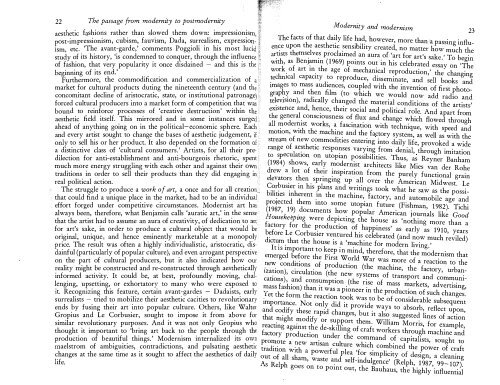The Condition of Postmodernity 13 - autonomous learning
The Condition of Postmodernity 13 - autonomous learning
The Condition of Postmodernity 13 - autonomous learning
You also want an ePaper? Increase the reach of your titles
YUMPU automatically turns print PDFs into web optimized ePapers that Google loves.
22 <strong>The</strong> passage from modernity to postmodernity1 . f shions rather than slowed.them down: impressionism,d 1 . .. press1·onism cubism, faUVIsm, Da a, surrea Ism, expresSlOn-. '<strong>The</strong> avant-garde ,' comments PogglO 1 m IS most UC1study <strong>of</strong> its history, 'is condene to conquer h h h . : t roug t e 1 fl ence<strong>of</strong> fashion, that very populanty It once d1sdamed - and thIs IS theaest letIc aPost-1m , . 1· · h· l ·dIsm, etċbeginning <strong>of</strong> its end.'. 1· · fh the Commodification and commerCla 1zatlOn 0 amarket for cultural products duting the nineṭeenh entury an t e 'concomitant decline <strong>of</strong> aristocratic, state, or mStItutlOa patronage)forced cultural producers into a market form <strong>of</strong> cOmetIlOn .t t whsbound to reinforce processes <strong>of</strong> 'creativ destruclOn wit m t eaesthetic field itselḟ This mirrored a? m some lstances surgedahead <strong>of</strong> anything going on in the pohtlcal-econom:c . sphere. Eacand every artist sought to change the bases <strong>of</strong> aesthetlc Judgemnt, Ifonly to sell his or her product. It also dep ende on the formalOn <strong>of</strong>a distinctive class <strong>of</strong> 'cultural consumers , : ArtIsts, .for all t?e1r predilectionfor anti-establishment and antl-bourgeOls r?etonc, . spentmuch more energy struggling with each other and agạmst the1traditions in order to sell their products than they dId engagmg onInreal political action.<strong>The</strong> struggle to produce a work <strong>of</strong> art, a once and for a 11 . cetIon .that could find a unique place in the market, had to be an . md1v1dualeffort forged under competitive circumstances. oderlst art hasalways been, therefore, what Benjamin calls . 'aụratIc art< m ṭhe senseFurt ermore,( d hthat the artist had to assume an aura <strong>of</strong> CreatiVIty, ?f dedIcation tfor . art's sake, in order to produce a cultural object that wouongma. 1 " unique and hence eminently marketable at a mo?op 1 yerice. <strong>The</strong> result was <strong>of</strong>ten a highly m 1V1 ua 1StIC, anstocrat1c, .1S-ainful (particularly <strong>of</strong> popular culture), and even rrọgant perspectiveon the part <strong>of</strong> cultural producers, but it also md1cated ho ourreality might be constructed and re-constructed through aethetIclliinformed activity. It could be, at best, pr<strong>of</strong>oundly movmg, alenging, upsetting, or exhortator to many who were epose toit Recognizing this feature, certam avant gardṣ - DadaIsts :surrealists - tried to mobilize their aesthetic cacltles to re,":olutIonaryearlyends by fusing their art into popular clture. thers, hke WalterGropius and Le Corbusier, sought to Impose It from aove forsimilar revolutionary purposes. And it was not only Gropms whothought it important to 'bring art back t? th peopl throgh theroduction <strong>of</strong> beautiful things.' Moderlllsm mternahed ItS onaelstrom <strong>of</strong> ambiguities, contradictions, and pulsatln aesthelcchanges at the same time as it sought to affect the aesthetics <strong>of</strong> dallylife.. d· ·d 1· · · dModernity and modernism<strong>The</strong> facts <strong>of</strong> that daily life had, however, more than;a passing influenceupon the aesthetic sensibility created, no matter how much theartists themselves proclaimed an aura <strong>of</strong> 'art for art's sake.' To beginwith, as Benjamin (1969) points out in his celebrated essay on '<strong>The</strong>work <strong>of</strong> art in the age <strong>of</strong> mechanical reproduction,' the changingtechnical capacity to reproduce, disseminate, and sell books andimages to mass audiences, coupled with the invention <strong>of</strong> first photographyand then film (to which we would now add radio andtelevision), radically changed the material conditions <strong>of</strong> the artists'existence and, hence, their social and political rolė And apart fromthe general consciousness <strong>of</strong> flux and change which flowed throughall modernist works, a fascination with technique, with speed andmotion, with the machine and the factory system, as well as with thestream <strong>of</strong> new commodities entering into daily life, provoked a widerange <strong>of</strong> aesthetic responses varying from denial, through imitationto speculation on utopian possibilities. Thus, as Reyner Banham(1984) shows, early modernist architects like Mies van der Rohedrew a lot <strong>of</strong> their inspiration from the purely functional grainelevators then springing up all over the American Midwesṫ LeCor busier in his plans and writings took what he saw as the possibilitiesinherent in the machine, factory, and automobile age andprojected them into some utopian future (Fishman, 1982). Tichi(1987, 19) documents how popular American journals like GoodHousekeeping were depicting the house as 'nothing more than afactory for the production <strong>of</strong> happiness' as early as 1910, yearsbefore Le Corbusier ventured his celebrated (and now much reviled)dictu.m. that the house is ạ 'm chine for modern living.'I t IS Important to keep In mmd, therefore, that the modernism thatemerged before the First World War was more <strong>of</strong> a reaction to the?e condtions .<strong>of</strong> production (the machine, the factory, urban-1zalOn), cIrculatIon (th new sysems <strong>of</strong> transport and communications),. and consmptlOn . (the rse <strong>of</strong> mass markets, advertising,mass fashlOn) than It was a plOneer m the production <strong>of</strong> such changes.yet the form the reaction took was to be <strong>of</strong> considerable subsequentlffiporta?ce. Not only did it provide ways to absorb, reflect upon,and codIfy these rapid changes, but it also suggested lines <strong>of</strong> actionthat :l1ight odify or sUPI?0rt them. William Morris, for example,reactmg agamst the de-sklllmg <strong>of</strong> craft workers through machine andfactory production under the command <strong>of</strong> capitalists, sought topro)te a ?ew artisan culture which combined the power <strong>of</strong> crafttradltlOn WIth a powerful plea 'for simplicity <strong>of</strong> design, a cleaningout <strong>of</strong> all sham, waste and self-indulgence' (Relph, 1987, 99-107).As Relph goes on to point Out, the Bauhaus, the highly influential23
















